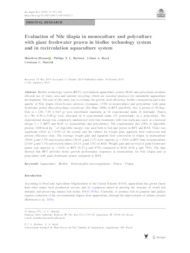Evaluation of Nile tilapia in monoculture and polyculture with giant freshwater prawn in biofloc technology system and in recirculation aquaculture system.
Evaluation of Nile tilapia in monoculture and polyculture with giant freshwater prawn in biofloc technology system and in recirculation aquaculture system.
Summary: Abstract: Biofloc technology system (BFT), recirculation aquaculture system (RAS) and polyculture promote efficient use of water, area and nutrient recycling, which are essential practices for sustainable aquaculture development. The aim of this study was to evaluate the growth, feed efficiency, biofloc composition and water quality of Nile tilapia Oreochromis niloticus (Linnaeus, 1758) in monoculture and polyculture with giant freshwater prawn Macrobrachium rosenbergii (De Man, 1906) in BFT and RAS, over a period of 30 days. Fish (n = 128; 7.29 +/- 0.67 g) were distributed randomly in 16 experimental tanks (8 fish/tank). Prawn (n = 96; 0.50 +/- 0.09 g) were allocated in 8 experimental tanks (12 prawn/tank) in a polyculture. The experimental design was completely randomized with four treatments with four replicates each, in a factorial design 2 x 2 (BFT and RAS vs. monoculture and polyculture). The experimental diet (28% of digestible protein; 3100 kcal kg(-1) of digestible energy) was used both to fish and prawn in BFT and RAS. There was significant effect (p < 0.01) of the system and the culture for weight gain, apparent feed conversion and protein efficiency ratio. The average weight gain and apparent feed conversion of tilapia in monoculture (30.04 g and 1.39) and in polyculture (36.44 g and 1.27) were superior (p < 0.01) in BFT than in monoculture (23.64 g and 1.74) and in polyculture (24.14 g and 1.61) in RAS. Weight gain and survival of giant freshwater prawn was superior (p < 0.01) in BFT (0.43 g and 87%) compared to RAS (0.26 g and 79%). The data showed that BFT provides better growth performance responses in monoculture for Nile tilapia and in polyculture with giant freshwater prawn compared to RAS.
Publication year: 2019
Types of publication: Journal article
Unit: Embrapa Environment
Observation
Some of Embrapa's publications are published as ePub files. To read them, use or download one of the following free software options to your computer or mobile device. Android: Google Play Books; IOS: iBooks; Windows and Linux: Calibre.
Access other publications
Access the Agricultural Research Database (BDPA) to consult Embrapa's full library collection and records.
Visit Embrapa Bookstore to purchase books and other publications sold by Embrapa.

